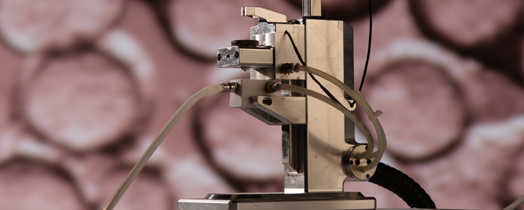Growing Stem Cells Faster on Seaweed
Alginate forms a kind of supporting skeleton in the cell walls of certain kinds of algae. Fraunhofer scientists use the gel-like mass from Chilean seaweed as the substrate for stem cells. They can flexibly adjust the pore size and elasticity of the alginate, and it transports active ingredients and has better optical characteristics than plastic materials.

For the drug tests of the future, the pharma industry needs large quantities of pluripotent stem cells. These stem cells have the potential to transform themselves into any kind of somatic cell, such as the cells of inner organs. Many thousands of stem cell lines from a huge variety of patients are currently being built up in biobanks, where doctors can access perfect models of the genetic illnesses of these patients. Using these stem cells, doctors and pharmaceutical companies can test new drugs better and more quickly than before.
Scientists at the Fraunhofer Institute for Biomedical Engineering IBMT in Sulzbach have identified seaweed from Chile as a particularly efficient source of nutrients for the expansion of pluripotent stem cells. Over the past few years, they have developed a controlled and documented production process for alginate, the seaweed’s supporting structure. The process encompasses everything from harvesting the seaweed on Chilean beaches and in the seas off Chile, to importing the granulated and dried seaweed, to manufacturing the alginate and using it in cell culture to grow pluripotent stem cells at the institute in Saarland. British pharma companies are currently validating the process in their laboratories. “The first concrete trials with partners from the European Federation of Pharmaceutical Industries and Associations (EFPIA) are planned for next year,” says Prof. Heiko Zimmermann, Managing Head of Fraunhofer IBMT. “The goal is to demonstrate that we can use the process to produce stable pluripotent stem cells. At the institute, we’ve already managed to do just that for many individual stem cell lines.” The Fraunhofer scientists at Sulzbach developed the production process and the technology platform jointly with their colleagues in Chile and the United Kingdom.
Alginate from two Chilean seaweed types particularly suitable
Two seaweed species that grow on the coast of Chile form the source material: Lessonia trabeculata and Lessonia nigrescens. Supporting structures in the cell walls of the seaweed are made of alginate, which is particularly suitable for stem cell cultivation: it consists of a highly aqueous gel that is more viscous than honey. When cross-linked with calcium or barium, it is both stable and flexible – like the jello you find in your dessert bowl – and also permeable for nutrients and important factors. “Cells feel especially at home in elastic 3D environments such as are found inside the body. It’s precisely this environment that can be simulated perfectly using alginate,” explains Prof. Zimmermann. This is an ideal environment particularly for heart muscle cells, which contract regularly. The scientists flexibly set the elasticity through the mixture of seaweed species and produce the alginate in beads of any size. “After all, different cells need different culture conditions,” says Prof. Zimmermann. “We also introduce active ingredients into the alginate and release them in a controlled manner.” Examples of such ingredients are substances that transform pluripotent stem cells into certain somatic cells. “In the future,” continues Prof. Zimmermann, “the alginate will not only act act as a passive substrate, but will also actively influence the growth of the stem cells.” The absence of autofluorescence in the elastic biomass is a further advantage and is important for optical analysis techniques. “The stem cells grow better on our alginate – and particularly well in automated bioreactors. They differentiate better into the desired somatic cells than on the plastic substrates generally used today,” says Prof. Zimmermann.
Harvesting the seaweed is subject to rigorous controls: there are special licenses for Chilean fishers, who harvest only the seaweed that is suitable for manufacturing the alginate, and only as much as permits sustainable resource management on the Chilean coast. In a laboratory operated by IBMT and Fraunhofer Chile at UCN University in Coquimbo, the seaweed is individually peeled, shredded, and completely dried. This is all done within 24 hours to prevent the material from becoming contaminated. The seaweed granulate is then exported to Germany, where IBMT scientists separate out the alginate in the institute’s cleanroom. After this process, it is available in liquid form and can be shaped into beads using a strong jet of air. “The beads are rendered more stable in a barium bath, as barium tends to remain in the seaweed mass. The trick is to make the material stable, but not too hard,” says Prof. Zimmermann.
The researchers place the protein-coated alginate into a bioreactor, which provides the optimum temperature and CO2 environment and continuously stirs the nutrients and cells. Measuring around 200 micrometers, each individual alginate bead performs the role of a Petri dish. The stem cells grow over the alginate in the containers in three to seven days, propagating as they do so. “Because the alginate volumes in the reactors can be increased slightly, we can grow pluripotent stem cells in greater quantities and in smaller spaces,” says Prof. Zimmermann.